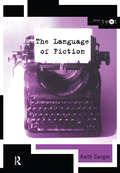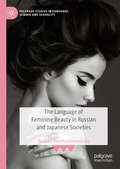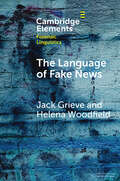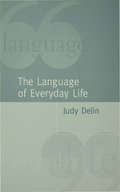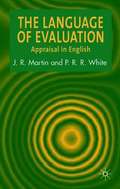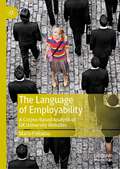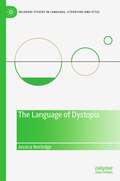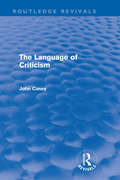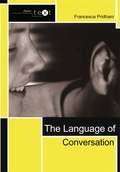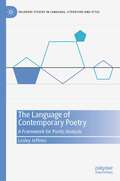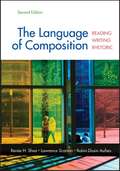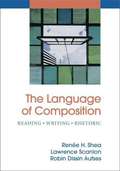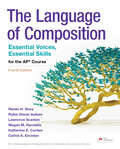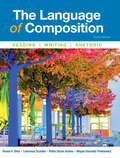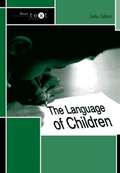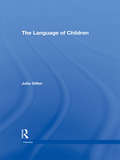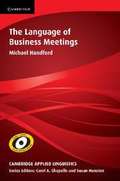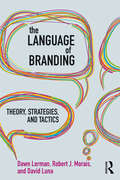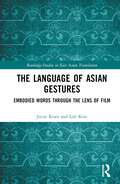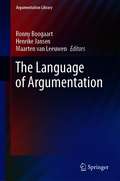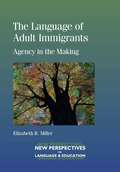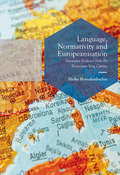- Table View
- List View
The Language of Fiction (Intertext Ser.)
by Keith SangerWhat makes literature? How does it work? How do we read it? This work explores these questions and varying literary styles and authorship. It deals with openings, point of view, speech, gender and pop fiction. The book includes a wide-range of literary extracts, from the classics of Hardy and Austen, to the contemporary work of Raymond Carver, Angela Carter, Nick Hornby and Irvine Welsh.
The Language of Feminine Beauty in Russian and Japanese Societies (Palgrave Studies in Language, Gender and Sexuality)
by Natalia KonstantinovskaiaThis book conducts a cross-linguistic and cross-cultural study of 'women’s language' as it pertains to feminine beauty. It examines the ideological constructs of beauty and femininity in the cultures of Japan and Russia, as embodied through televised beauty ads, and relates them to the real-world language practices of Japanese and Russian women. The author traces the reciprocal connection between women’s real and imagined language in the construction of ideals of beauty and femininity, revealing the complex ways women respond to ideological expectations regarding language use: assimilating, transforming, and subverting ideologized language and the assumptions implicit in it. She also demonstrates ways in which women alter the texture of language by appropriating 'masculine' language for their own purposes, shifting the meaning and correlates of linguistic items and structures. This book will be of interest to students and scholars of sociolinguistics, language and gender, cultural and media studies, and Russian and Japanese culture.
The Language of Fake News (Elements in Forensic Linguistics)
by Jack Grieve Helena WoodfieldIn this Element, the authors introduce and apply a framework for the linguistic analysis of fake news. They define fake news as news that is meant to deceive as opposed to inform and argue that there should be systematic differences between real and fake news that reflect this basic difference in communicative purpose. The authors consider one famous case of fake news involving Jayson Blair of The New York Times, which provides them with the opportunity to conduct a controlled study of the effect of deception on the language of a single reporter following this framework. Through a detailed grammatical analysis of a corpus of Blair's real and fake articles, this Element demonstrates that there are clear differences in his writing style, with his real news exhibiting greater information density and conviction than his fake news. This title is also available as Open Access on Cambridge Core.
The Language of Everyday Life: An Introduction
by Judy DelinThis is a lively, practical guide that provides a fascinating linguistic description of six familiar text and discourse types, showing how language works in everyday life to perform its particular purpose. Through original examples, students are introduced to a wide-ranging repertoire of analytical concepts and techniques, described in basic, clear terms, and drawn from a broad range of areas of linguistics and language study. The aim of the book is to enable students to discover for themselves what is interesting about different language situations, and to begin to interrogate the relationship between language, society, and ideology. The Language of Everyday Life includes: topics for discussion; exercises, and; further readings; extensive glossary of technical terms; a practical guide to project work.
Language of Evaluation: Appraisal in English
by J. R. Martin P. WhiteThe impetus for this book grew out of work on narrative genres, principally undertaken by Guenter Plum and Joan Rothery at the University of Sydney through the 1980s. Their point was that interpersonal meaning was critical both to the point of these genres (as emphasised by Labov) and also to how we classified them. This encouraged us to extend the model of interpersonal meaning that we had available at the time (based largely on work by Cate Poynton on language and gender), especially in the direction of one that could handle affect alongside modality and mood.
The Language of Employability: A Corpus-Based Analysis of UK University Websites
by Maria FotiadouThis book employs a corpus-based Critical Discourse Analysis (CDA) methodology to analyse the language used by university careers services in the UK. Drawing on a corpus which includes the public-facing websites of careers services from 24 Russell Group and 34 Post-92 universities, the author highlights some of the potentially problematic 'common-sense' views and ideas that are currently promoted to students using these services. She argues that the language used by university websites promotes neoliberal ideology and encourages the denaturalisation of such language. This book will be of interest to linguists, sociologists, education scholars, and scholars who are otherwise interested in the notion of employability.
The Language of Dystopia (Palgrave Studies in Language, Literature and Style)
by Jessica NorledgeThis book presents an extended account of the language of dystopia, exploring the creativity and style of dystopian narratives and mapping the development of the genre from its early origins through to contemporary practice. Drawing upon stylistic, cognitive-poetic and narratological approaches, the work proposes a stylistic profile of dystopia, arguing for a reader-led discussion of genre that takes into account reader subjectivity and personal conceptualisations of prototypicality. In examining and identifying those aspects of language that characterise dystopian narratives and the experience of reading dystopian fictions, the work discusses in particular the manipulation and construction of dystopian languages, the conceptualisation of dystopian worlds, the reading of dystopian minds, the projection of dystopian ethics, the unreliability of dystopian refraction, and the evolution and hybridity of the dystopian genre.
The Language of Criticism (Routledge Revivals)
by John CaseyFirst published in 1966, the Language of Criticism was the first systematic attempt to understand literary criticism through the methods of linguistic philosophy and the later work of Wittgenstein. Literary critical and aesthetic judgements are rational, but are not to be explained by scientific methods. Criticism discovers reasons for a response, rather than causes, and is a rational procedure, rather than the expression of simply subjective taste, or of ideology, or of the power relations of society. The book aims at a philosophical justification of the tradition of practical criticism that runs from Matthew Arnold, through T.S.Eliot to I.A.Richards, William Empson, F.R.Leavis and the American New Critics. It argues that the close reading of texts moves justifiably from text to world, from aesthetic to ethical valuation. In this it differs radically from the schools of "theory" that have recently dominated the humanities.
The Language of Conversation (Intertext)
by Francesca PridhamThis accessible satellite textbook in the Routledge Intertext series offers students hands-on practical experience of textual analysis of conversation. Written in a clear, user-friendly style by an experienced teacher, it combines practical activities with texts, accompanied by commentaries and suggestions for further study. It can be used individually or in conjunction with the series core textbook Working With Texts Aimed at A-Level and beginning undergraduate students, The Language of Conversation:* Analyses exactly what happens during conversation and why* Discusses the structure, purpose, and features of conversation* Explores the relationship between speaker and listener* Examines different kinds of conversation, such as chatroom conversations, extracts from chatshows and everyday conversation* Provides a clear introduction to technical terms.
The Language of Contention
by Sidney TarrowThis book examines the relations between the material and political bases of contentious politics and the construction, diffusion and endurance of contentious language. Beginning with the language of revolution developed from the seventeenth to the nineteenth centuries, it examines contentious language at work, in gender and race relations and in nationalist and ethnic movements. It closes with an examination of emotions in contentious politics, reflecting on the changes in political language since 9/11 and assessing the impact of religion and recent innovations in electronic communication on the language of politics.
The Language of Contemporary Poetry: A Framework for Poetic Analysis (Palgrave Studies in Language, Literature and Style)
by Lesley JeffriesThis book introduces a new way of looking at how poems mean, drawing on the framework first developed in the author’s book Critical Stylistics, but applied here to aesthetic more than ideological meaning. The aim is to empower readers of poetry to articulate the features of poetic language that they come across and explain to themselves and others why these features convey the meanings that they do. While this volume focuses on contemporary poets writing in English and mostly based in the UK and Ireland, the framework will work just as well for other eras’ poetry, as well as for other cultures and languages.
The Language Of Composition: Reading, Writing, Rhetoric
by Lawrence Scanlon Robin Aufses Renee SheaThe Language of Composition is the first textbook built from the ground up to help students succeed in the AP English Language course. Written by a team of experts with experience in both high school and college, this text focuses on teaching students the skills they need to read, write, and think at the college level. With practical advice and an extensive selection of readings -- including essays, poetry, fiction, and visual texts --The Language of Composition helps students develop the key skills they must master to pass the course, to succeed on the AP Exam, and to prepare for a successful college career. Revised based on feedback from teachers across the country, the second edition promises to be an even better resource for the AP Language classroom.
The Language of Composition: Reading, Writing, Rhetoric
by Renée H. Shea Lawrence Scanlon Robin Dissin AufsesThe Language of Composition is the first college-level textbook created specifically for the AP* English Language course. Inside, students will find everything they need to learn college-level reading, writing, and analysis skills: concise introductory chapters on rhetoric, close reading, and synthesizing sources; a rich collection of thematically arranged readings that includes essays, speeches, letters, newspaper columns, as well as fiction, poetry, and visual texts; carefully crafted assignments that reinforce the skills taught in the introductory chapters; and much more. The Language of Composition - designed to help students succeed in the AP English Language course and embark on a successful college career. Book jacket.
The Language of Composition: Reading, Writing, Rhetoric
by Renée H. Shea Lawrence Scanlon Robin Dissin AufsesNIMAC-sourced textbook
The Language of Composition: Reading, Writing, Rhetoric
by Renee H. Shea Lawrence Scanlon Robin Dissin AufsesThe ideal book for the AP English Language course. The Language of Composition is the first textbook built from the ground up to help students succeed in the new AP English Language course. Written by a team of experts with experience in both high school and college, this text focuses on teaching students the skills they need to read, write, and think at the college level. With practical advice on reading and writing and an extensive selection of readings#xA0;-- including essays, poetry, fiction, and visual texts that are both interesting and appropriate for a high school audience --The Language of Composition helps students develop the key skills they must master to pass the course, to succeed on the AP Exam, and to prepare for a successful college career.
The Language of Composition: Essential Voices, Essential Skills for the AP® Course
by Renee H. Shea Lawrence Scanlon Robin Dissin Aufses Megan M. Harowitz Katherine E. Cordes Carlos EscobarEverything You Need to Succeed in AP® Language.Give yourself the best foundation to earn a great score.The Language of Composition includes all of the skills instruction, practice, readings, and AP® tips you need to be successful on the AP® Language and Composition Exam.
The Language of Composition: Reading, Writing, Rhetoric
by Renée H. Shea Lawrence Scanlon Robin Dissin Aufses Megan Harowitz PankiewiczFor over a decade, The Language of Composition has been the most successful textbook written for the AP® English Language and Composition Course. Now, its esteemed author team is back, giving practical instruction geared toward training students to read and write at the college level. The textbook is organized in two parts: opening chapters that develop key rhetoric, argument, and synthesis skills; followed by thematic chapters comprised of the finest classic and contemporary nonfiction and visual texts. With engaging readings and reliable instruction, The Language of Composition gives every students the opportunity for success in AP® English Language.
The Language of Children
by Julia GillenThe Intertext series has been specifically designed to meet the needs of contemporary English language studies. Working with Texts: A Core Introduction to Language Analysis (second edition, 2001) is the foundation text, which is complemented by a range of satellite titles. These provide students with hands-on practical experience of textual analysis through special topics and can be used individually or in conjunction with Working with Texts.
The Language of Children (Intertext)
by Julia GillenThe Intertext series has been specifically designed to meet the needs of contemporary English Language Studies. Working with Texts: A Core Introduction to Language Analysis (second edition, 2001) is the foundation text, which is complemented by a range of 'satellite' titles. These provide students with hands-on practical experience of textual analysis through special topics and can be used individually or in conjunction with Working with Texts.The Language of Children: introduces the key theories of language acquisition and provides a historical overview of the subject looks at all the ways children learn to communicate, from writing and talking to playing and using computers includes a wide variety of real texts and data, from records of childrens first words to children's hand-written stories and emails explores the language of children from a range of backgrounds and abilities, including deaf and bilingual children is user-friendly and accessible, and provides a full glossary.
The Language of Business Meetings
by Michael HandfordThis innovative volume presents an in-depth study of the language used by participants in business meetings. The cutting-edge research draws on the Cambridge and Nottingham Business English Corpus (CANBEC), a unique resource which brings together meetings of different types both within and between companies, involving speakers whose roles and responsibilities vary, and who represent a range of nationalities and first languages. Keywords, concordance lines and discourse analysis provide thorough insights into aspects such as the structural stages of meetings, participants' discursive practices, interpersonal language and creativity, and power and constraint. The author concludes by making practical suggestions for using these findings to inform the teaching of business English.
The Language of Branding: Theory, Strategies, and Tactics
by Dawn Lerman Robert J. Morais David LunaThe Language of Branding: Theory, Strategies and Tactics shows marketers how to use language successfully to improve brand value and influence consumer behavior. Luna and Lerman are among only a few researchers who take a multidisciplinary perspective on the ways language influences how consumers act. Together with Morais, an anthropologist engaged in market research, they show how understanding the power of language can impact the essence – and sales – of a brand. The book covers the fundamentals of brand language and applications for an array of marketing initiatives. Readers will learn why brand language matters, how language is used in marketing, and how to build a brand strategy that capitalizes on the richness and complexity of language. This book includes real-world case histories that demonstrate vividly how brand language is created and exercises that enable both students of marketing and marketing professionals to apply the book’s concepts and stimulate class discussion. The Language of Branding: Theory, Strategies and Tactics can be used in a number of courses, including consumer behavior, branding, advertising, linguistics, and communications.
The Language of Asian Gestures: Embodied Words Through the Lens of Film (Routledge Studies in East Asian Translation)
by Jieun Kiaer Loli KimThe Language of Asian Gestures explores Asian gestures as a non-verbal language within the context of films and dramas.This book provides a cross-cultural Asian perspective on a range of important common gestures and their meanings, covering a range of Asian regions including Korea, China, Hong Kong, Japan, Taiwan, Vietnam, Singapore, Thailand, Indonesia, the Philippines, India, and Pakistan. While most studies focus on text-based communication, gestures find themselves overshadowed by text and speech. Asian gestures, too, often reside in the shadow of Eurocentric viewpoints. This book will shift this dynamic and amplify the voices that have typically been marginalised within 20th-century Eurocentric discussions.The book will be informative for students and researchers interested in Asian languages, cultures, film studies, and pragmatics. It bridges the gap between words and gestures, unveiling a world of concealed meanings and enriching our understanding of diverse forms of expression.
The Language of Argumentation (Argumentation Library #36)
by Ronny Boogaart Henrike Jansen Maarten Van LeeuwenBringing together scholars from a broad range of theoretical perspectives, The Language of Argumentation offers a unique overview of research at the crossroads of linguistics and theories of argumentation.In addition to theoretical and methodological reflections by leading scholars in their fields, the book contains studies of the relationship between language and argumentation from two different viewpoints. While some chapters take a specific argumentative move as their point of departure and investigate the ways in which it is linguistically manifested in discourse, other chapters start off from a linguistic construction, trying to determine its argumentative function and rhetorical potential. The Language of Argumentation documents the currently prominent research on stylistic aspects of argumentation and illustrates how the study of argumentation benefits from insights from linguistic models, ranging from theoretical pragmatics, politeness theory and metaphor studies to models of discourse coherence and construction grammar.
The Language of Adult Immigrants
by Elizabeth R. MillerThis book is the first to explore the constitution of language learner agency by drawing on performativity theory, an approach that remains on the periphery of second language research. Though many scholars have drawn on poststructuralism to theorize learner identity in non-essentialist terms, most have treated agency as an essential feature that belongs to or inheres in individuals. By contrast, this work promotes a view of learner agency as inherently social and as performatively constituted in discursive practice. In developing a performativity approach to learner agency, it builds on the work of Vygotsky and Bakhtin along with research on 'agency of spaces' and language ideologies. Through the study of discourses produced in interviews, this work explores how immigrant small business owners co-construct their theories of agency, in relation to language learning and use. The analysis focuses on three discursive constructs produced in the interview talk-subject-predicate constructs, evaluative stance, and reported speech-and investigates their discursive effects in mobilizing ideologically normative, performatively realized agentive selves.
Language, Normativity and Europeanisation
by Heiko MotschenbacherThis book focuses on linguistic practices of identity construction in a popular culture media context, the Eurovision Song Contest. Subscribing to a normativity-based approach to critical discourse analysis, it studies Europeanisation as it surfaces at the discursive interface of European, national and sexual identities in Eurovision lyrics and performances. Research in critical discourse analysis that deals with Europeanisation, or the discursive work involved in European identity formation, has so far mainly studied data from EU political contexts that illustrate a top-down approach to what Europeanness means. The present book complements this earlier research in several ways, focusing on the linguistic construction of identities, and its interrelation with non-linguistic modes of signification in the Eurovision Song Contest. Discursive mechanisms that prove to be central for the normative shifts of Europeanisation in the given context are de-essentialisation, inclusion, camp, crossing and languaging.
